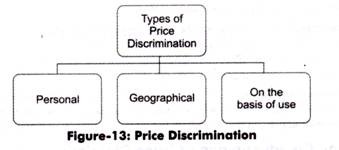Price Discrimination
The monopolist often charges different prices from different consumers for the same product. This practice of charging different prices for identical product is called price discrimination.
According to Robinson, “Price discrimination is charging different prices for the same product or same price for the differentiated product.”
Types of Price Discrimination:
Price discrimination is a common pricing strategy’ used by a monopolist having discretionary pricing power. This strategy is practiced by the monopolist to gain market advantage or to capture market position.
There are three types of price discrimination, which are shown in Figure-13:
The different types of price discrimination (as shown in Figure-13) are explained as follows:
i. Personal:
Refers to price discrimination when different prices are charged from different individuals. The different prices are charged according to the level of income of consumers as well as their willingness to purchase a product. For example, a doctor charges different fees from poor and rich patients.
ii. Geographical:
Refers to price discrimination when the monopolist charges different prices at different places for the same product. This type of discrimination is also called dumping.
iii. On the basis of use:
Occurs when different prices are charged according to the use of a product. For instance, an electricity supply board charges lower rates for domestic consumption of electricity and higher rates for commercial consumption.
Conditions of Price-Discrimination:
There are three main types of situation:
(a) When consumers have certain preferences or prejudices. Certain consumers usually have the irrational feeling that they are paying higher prices for a good because it is of a better quality, although actually it may be of the same quality. Sometimes, the price differences may be so small that consumers do not consider it worthwhile to bother about such differences.
(b) When the nature of the good is such as makes it possible for the monopolist to charge different prices. This happens particularly when the good in question is a direct service.
(c) When consumers are separated by distance or tariff barriers. A good may be sold in one town for Rs.1 and in another town for Rs.2. Similarly, the monopolist can charge higher prices in a city with greater distance or a country levying heavy import duty.
Conditions Making Price Discrimination Possible and Profitable:
The following conditions are essential to make price discrimination possible and profitable:
(a) The elasticity’s of demand in different markets must be different. The market is divided into sub-markets. The sub-market will be arranged in ascending order of their elasticity’s, the higher price being charged in the least elastic market and vice versa.
(b) The costs incurred in dividing the market into sub-markets and keeping them separate should not be so large as to neutralize the difference in demand elasticity’s.
(c) There should be complete agreement among the sellers otherwise the competitors will gain by selling in the dear market.
(d) When goods are sold on special orders because then the purchaser cannot know what is being charged from others.

Comments
Post a Comment